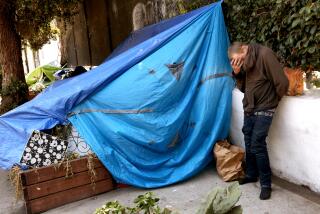Inside the California Poppy House that has sprouted in Venice
When it came to designing their new home in Venice, Jonathan Ward and Jin Ah Park drew inspiration from a two-year backpacking trip around the world. The couple traveled from Britain to Thailand, Australia to Peru, Morocco to Mali — a journey that has given rise to a modern dwelling that draws from global cultures yet still embodies California living.
Dubbed the California Poppy House, the 2,900-square-foot design calls upon the state flower for the home’s most striking feature: the silhouette of the flower, cut into an aluminum screen that wraps the second-floor facade. It’s a dramatic effect, especially in the evening as the house lights up.
PHOTO GALLERY: The California Poppy House in Venice
The front also is noteworthy for the low fence that leaves the house partially exposed to its neighborhood — a sense of openness that the couple feels strongly about, Ward said. During the last 20 years, because of crime and other concerns in Venice, “people built big, tall fences; they walled themselves in,” he said. “We feel it’s important to have a porch that engages the street, engages the city, so we get the opportunity to know our neighbors.”
Past the gate, the entry path follows the logic of Japanese gardens with an indirect route from the street to the front door. Lined with tall ornamental grass that sways in the wind and California flora from the Theodore Payne Foundation for Wildflowers and Native Plants, the extended entry procession allows visitors to decompress mentally as they make their way toward the home.
Inside, the plan by Ward, a partner at the international design firm NBBJ, and Park, an NBBJ principal on leave, reveals itself as essentially a dark-stained cedar box with two aluminum boxes within to delineate the private spaces.
Telescoping floor-to-ceiling glass walls open up the first-floor living and dining areas to a decked courtyard that captures southwesterly breezes. The layout, which emphasizes connectivity to nature, borrows from courtyard houses the couple saw in South Korea and China. The only air-conditioning throughout the house is courtesy of Mother Nature: Glass sliders on the second floor, including two glass pocket doors in the bedroom of son Jonah, 5, borrow design inspiration from Moroccan balconies to let in more light and fresh air.
The couple brought some simplicity to their decor as well. No photographs or paintings hang on the walls. Only a few meaningful trinkets are displayed — an act of curation that they said adds a sense of calm to their home, some relief from the frenetic pace of modern life.
“When we came back to America, we just noticed there was so many junk channels but nothing to really see and no true information,” Park said, explaining why they even dispensed with the television. “I didn’t feel it was feeding our inspiration, creativity or spirituality. It was just this constant barrage of things to buy.”
During their global travels, they lived with so little for so long, Park said. “It really made us understand, appreciate and practice simplicity. That had a big part in the way we built our home and how we live.”
Though simplicity is embedded into the house, building it was anything but. Park and Ward bought the property in 2007. Securing a construction loan was difficult, and the two were put to the test when their general contractor became insolvent during the recession, they said.
“Ten months into the project with just 48% of the home done, they came to us and said, ‘We can’t finish the project,’” Park said. “We were terrified.”
Park assumed the responsibilities of a general contractor, trying to keep construction on schedule and managing the crews while being mom to Jonah, then 3.
“It was quite a task,” Park said. “The subcontractors were all under me, all of a sudden. I had to pay them and deal with all their contracts.” As Ward flew to and from China for work, he squeezed in time to finish design details.
In the end, the couple said they built a home that reflects their goals, including solar panels on the roof that help the three-bedroom, three-bathroom home achieve net-zero energy usage.
“We had ideas on openness, daylight and wind,” Ward said. “We’re not trained as climate engineers or mechanical engineers. We just had a feel for it, and it worked.”
Updated: This story was updated June 8 with additional details on the design and the design and construction process. The story was first published May 16.
Corrected: An earlier version of this article gave an incorrect title for Jin Ah Park.
-----
SEE IT FOR YOURSELF
What: AIA Los Angeles spring home tour, a self-guided walking tour with four stops including the California Poppy House.
When: 11 a.m. to 4 p.m. May 18.
Tickets: $85 on the day of the event, bought at the will call location, 728 Woodlawn Ave., Venice.
Information: (213) 639-0777, AIA website.
-----
For an easy way to follow the L.A. scene, bookmark L.A. at Home and join us on Facebook, Twitter and Pinterest.


